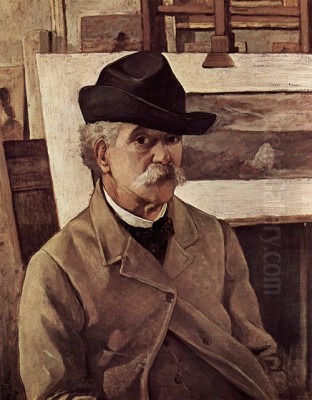
Giovanni Fattori stands as one of the most significant figures in nineteenth-century Italian art. A painter and printmaker of remarkable versatility and vision, he navigated the turbulent currents of his time, forging a path away from staid academic traditions towards a powerful, light-filled realism. Born in the bustling port city of Livorno in 1825 and passing away in Florence in 1908, Fattori's long life witnessed profound changes in Italy, both politically and artistically. He became a leading member of the Macchiaioli group, artists who revolutionized Italian painting by emphasizing the direct observation of nature and the use of bold patches of colour and light. His legacy encompasses evocative landscapes, poignant military scenes, insightful portraits, and groundbreaking etchings, all marked by a profound honesty and a unique sensitivity to the visual world.
Early Life and Artistic Formation
Giovanni Fattori's journey began in Livorno, Tuscany, on September 6, 1825. Livorno, a vibrant maritime center, likely exposed the young Fattori to a diverse range of sights and experiences, perhaps fostering an early appreciation for the tangible world. His initial artistic training was under a local painter, Giuseppe Baldini. However, seeking more formal instruction, Fattori moved to Florence around 1846. Florence, the cradle of the Renaissance, remained a vital artistic hub, though its official art institutions were steeped in academic convention.
In Florence, Fattori initially studied privately with Giuseppe Bezzuoli, a respected painter whose own work often balanced Neoclassical clarity with Romantic sentiment. Subsequently, Fattori enrolled at the prestigious Accademia di Belle Arti (Academy of Fine Arts). During these formative years, the prevailing artistic climate emphasized historical and literary subjects, rendered with meticulous detail and idealized forms. Fattori's early works reflect this training, often tackling grand historical or religious themes, such as his "John the Baptist Condemning Herod Antipas." These pieces demonstrate his developing technical skill but give little hint of the radical stylistic departure to come. The political atmosphere of the Risorgimento, the movement for Italian unification, also permeated the air, influencing many artists to engage with themes of national identity and contemporary history, often through the lens of military events.
The Macchiaioli Revolution
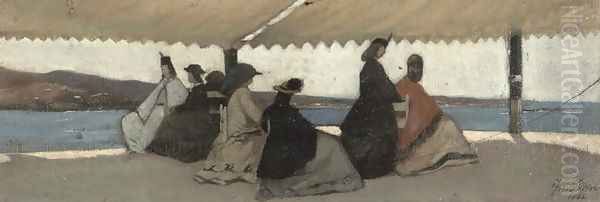
The rigid constraints of academic painting began to chafe against the sensibilities of a new generation of artists in Florence. Around the mid-1850s, a group began congregating at the Caffè Michelangiolo, a bustling hub of intellectual and artistic debate. These artists, including Fattori, Telemaco Signorini, Silvestro Lega, Odoardo Borrani, Adriano Cecioni, and others, shared a dissatisfaction with the artificiality of academic art and a desire to depict the world with greater truthfulness, or il vero. They sought inspiration directly from nature and contemporary life.
Their revolutionary approach involved painting with macchie – broad, distinct patches or spots of colour and chiaroscuro (light and shadow) – applied directly to the canvas, often outdoors (en plein air), to capture the immediate visual impact of a scene. This technique aimed to represent the way the eye perceives form and light, rather than relying on traditional methods of smooth blending and detailed drawing. The term "Macchiaioli" was initially coined derisively by a critic in 1862, referencing these "stains" or "blotches," but the artists embraced it. Fattori emerged as one of the most prominent and respected figures within this movement, bringing a particular gravity and structural solidity to the Macchiaioli aesthetic. Other key figures associated with the group included Giuseppe Abbati, Vincenzo Cabianca, Cristiano Banti (who was also a patron), and Vito D'Ancona.
Embracing the Tuscan Landscape
A crucial development in Fattori's art was his decisive turn towards landscape painting and scenes of rural life, moving away from the historical narratives of his youth. This shift was deeply influenced by his experiences painting outdoors and his profound connection to the Tuscan countryside, particularly the wild, sun-drenched region of the Maremma in southern Tuscany. The stark beauty, intense light, and traditional ways of life in the Maremma provided him with endless inspiration.
His approach to landscape was grounded in direct observation and the Macchiaioli principles. He sought to capture the specific atmosphere and light effects of the Tuscan environment. His compositions often feature strong horizontal lines, simplified forms, and a powerful sense of structure, perhaps echoing the clarity of early Italian masters like Piero della Francesca, whom he admired. He masterfully rendered the play of sunlight and shadow across fields, walls, and figures, using contrasting macchie to define form and space.
The influence of the French Barbizon School painters, such as Jean-Baptiste-Camille Corot, Théodore Rousseau, and Jean-François Millet, is also evident. Like them, Fattori valued naturalism, the depiction of rural labor, and the poetic rendering of landscape. However, Fattori's work retained a distinctly Italian character, marked by its brighter light and often more rigorously defined structure.
Masterpieces of Light and Place
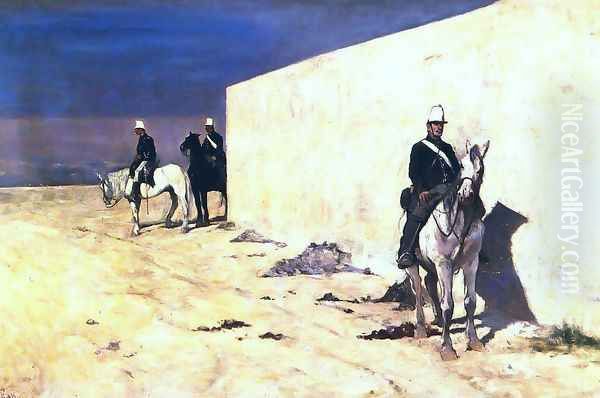
Several works exemplify Fattori's mastery of landscape and his connection to Tuscany. "La Rotonda di Palmieri" (The Palmieri Bathing Establishment, c. 1866) is perhaps one of his most famous paintings. It depicts figures relaxing under the shade of a bathing structure by the sea near Livorno. The composition is strikingly modern, with its bold horizontal bands of colour representing the sky, sea, sand, and awning. The figures are rendered with simplified macchie, yet they possess a distinct presence. The painting perfectly captures a fleeting moment of leisure under the intense Mediterranean sun, showcasing the Macchiaioli technique at its most effective.
His paintings of the Maremma often feature the iconic butteri (Maremman cowboys) and the distinctive long-horned cattle of the region. Works like "The Ox Cart" (Il Carro dei Buoi) or "The Wine Cart" (Il Carro del Vino) depict scenes of rural labor with an unsentimental realism, focusing on the relationship between humans, animals, and the land. He captured the dusty roads, the stark white walls under the sun (as in "Il Muro Bianco" - The White Wall), and the vast, open spaces characteristic of the area. Other notable landscapes include views like "The Top of Romito with Boat and Fishermen," capturing the coastal beauty near Livorno.
War and Realism: A Soldier's View
While Fattori moved away from traditional historical painting, he frequently returned to military themes, but approached them through the lens of realism and his own experiences. He had witnessed French troops landing in Livorno during the Second Italian War of Independence (1859) and observed military life firsthand. This informed his depictions, which largely eschewed the heroic glorification typical of official battle paintings.
Instead, Fattori focused on the everyday realities of soldiering: the waiting, the fatigue, the patrols, the moments between battles. His military paintings often emphasize the landscape and atmosphere, with soldiers appearing as small figures within a larger setting. "Il campo italiano alla battaglia di Magenta" (The Italian Camp after the Battle of Magenta, 1862) is a prime example. Rather than depicting the heat of combat, it shows the aftermath, focusing on the wounded being tended to in a field hospital under a vast sky, conveying the human cost of war with quiet dignity.
Works like "In vedetta" or "Pattuglia" ("On Patrol") capture the tension and isolation of soldiers on watch, often silhouetted against the landscape. The famous "Cavallo bianco" ("White Horse") is another powerful image, depicting a lone horse standing riderless, suggesting loss and the quiet aftermath of conflict. Fattori's military scenes are characterized by their compositional strength, evocative use of light, and profound sense of realism, offering a human perspective on the events of the Risorgimento.
Intimate Portraits and Genre Scenes
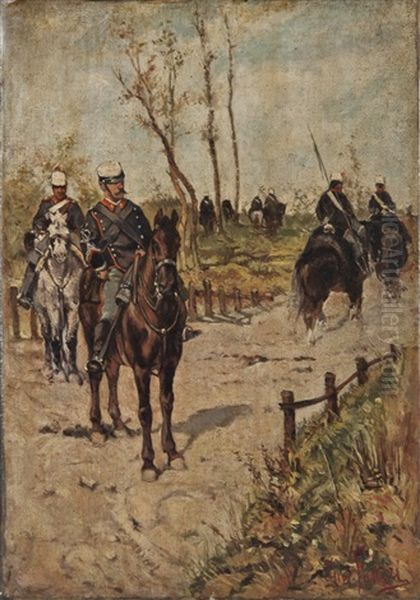
Beyond landscapes and military subjects, Fattori was also a sensitive portraitist and painter of genre scenes. His portraits reveal a keen observation of character and an ability to capture the inner life of his subjects. "Signora Martelli a Castiglioncello" (c. 1867), depicting the wife of his friend and art critic Diego Martelli reading in a garden, is a masterpiece of quiet intimacy. The play of dappled sunlight, the relaxed pose of the figure, and the lush garden setting are rendered with characteristic Macchiaioli freshness.
Fattori's personal life, including his three marriages, also found reflection in his art. He painted sensitive portraits of his family members, capturing moments of domesticity with warmth and insight. These works, along with his depictions of peasants working or resting, demonstrate his consistent interest in the vero – the authentic portrayal of everyday life, observed without sentimentality but with deep human understanding. His focus remained on the tangible reality of the world around him, whether in the vastness of the Maremma or the quiet corner of a garden.
The Art of Etching: A Late Mastery
In the later part of his career, particularly from the early 1880s onwards, Fattori dedicated significant energy to the art of etching. He became one of Italy's most important printmakers of the period, producing around 200 plates. Etching, with its potential for strong linear definition and rich tonal contrasts, proved an ideal medium for his artistic temperament. He explored its possibilities with great innovation, working primarily on copper and zinc plates.
His etchings often revisit themes familiar from his paintings – landscapes, military life, rural scenes – but translated into the graphic language of line and tone. He demonstrated a profound understanding of how to use etched lines and selective wiping of ink (creating plate tone) to evoke light, shadow, and atmosphere. His compositions remained powerful and direct, often characterized by bold simplification and a focus on essential forms. In 1884, he published an album titled "20 Ricordi dal Vero" (20 Memories from Life), showcasing his mastery of the medium. Notable etchings include works like "Antico Castello di Vinciliata" and "Mercato" (Market), the latter once famously considered 'lost' before being located. His innovative approach to printmaking significantly influenced later artists, including the sculptor and printmaker Marino Marini, who studied with him.
Fattori's Signature Style: Synthesis and Structure
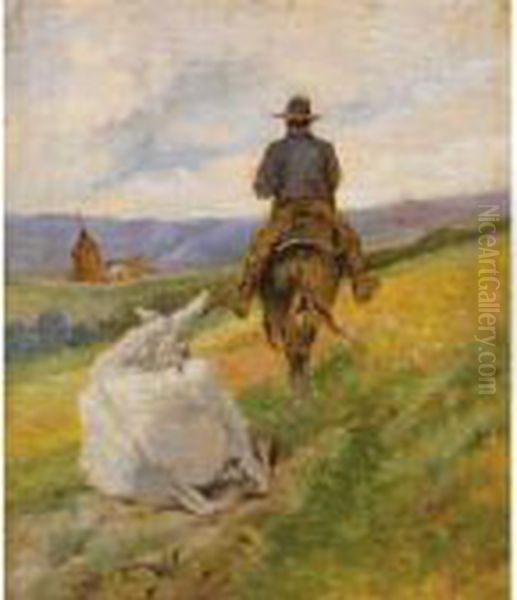
Giovanni Fattori's artistic style is defined by its commitment to realism, its innovative use of the macchia, and its underlying structural solidity. He built his compositions through contrasting patches of light and dark, colour and tone, creating forms that possess weight and volume. Unlike the French Impressionists, who often sought to dissolve form in light, Fattori maintained a strong sense of underlying geometry and structure, perhaps reflecting his admiration for early Italian art.
His landscapes are often characterized by strong horizontal elements, creating a sense of calm and expanse. His figures, whether soldiers, peasants, or bourgeoisie, are depicted with an objective eye, yet convey a powerful sense of presence and psychological depth. The handling of light is central to his work; he masterfully captured the intense sunlight of Tuscany, the cool shadows, and the specific atmospheric conditions of different times of day. His palette, while embracing the brighter colours favoured by the Macchiaioli, often retained earthy tones appropriate to his subjects. Overall, his style represents a unique synthesis of direct observation, formal rigor, and poetic sensibility.
Circle of Influence: Teachers, Peers, and Pupils
Fattori's long career placed him at the center of a vibrant network of artists. His teachers, Giuseppe Baldini in Livorno and Giuseppe Bezzuoli in Florence, provided his foundational training. His peers in the Macchiaioli movement were crucial interlocutors and collaborators; key among them were Telemaco Signorini (a close friend and fellow theorist), Silvestro Lega, Giuseppe Abbati (with whom he sometimes painted), Odoardo Borrani, Adriano Cecioni, Vincenzo Cabianca, Vito D'Ancona, and Cristiano Banti. The critic Diego Martelli was an important supporter and friend.
He absorbed influences from the French Barbizon School, admiring the naturalism of Corot, Millet, and Rousseau. He also engaged with other contemporaries, occasionally collaborating, as evidenced by works co-signed with the portraitist Michele Gordigiani. Furthermore, Fattori became an influential teacher himself. His pupils included Amedeo Modigliani, who studied with him briefly in Livorno and Florence before developing his unique modern style, the aforementioned Marino Marini, and other Tuscan painters like Plinio Nomellini and the Welsh-Italian artist Llewelyn Lloyd, ensuring the continuation of his influence into the 20th century.
Final Years and Enduring Legacy
Despite his growing reputation and a teaching position at the Florence Academy, Giovanni Fattori faced financial difficulties in his later years. Anecdotes suggest a somewhat gruff and reserved personality, perhaps linked to his documented skepticism towards religion and a certain philosophical pessimism. He continued to paint and etch prolifically, driven by both artistic passion and economic necessity. He passed away in Florence on August 30, 1908, and was buried, according to his wishes, in his native Livorno.
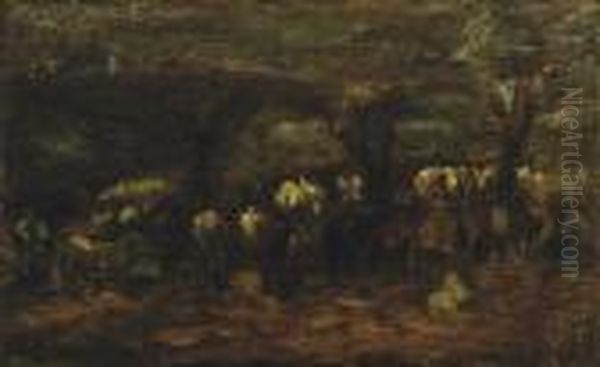
Today, Giovanni Fattori is recognized as a pivotal figure in modern Italian art. He was instrumental in breaking from academic constraints and establishing a powerful realist tradition. As a leading Macchiaiolo, he pioneered new ways of seeing and representing the world, particularly the effects of light and atmosphere. His depictions of Tuscan landscapes, Maremman life, and the human side of the Risorgimento remain iconic images of nineteenth-century Italy. His mastery extended to etching, where he made significant technical and artistic contributions. His work is housed in major Italian museums, including the Galleria d'Arte Moderna at the Pitti Palace in Florence, the Galleria Nazionale d'Arte Moderna in Rome, and notably, the Museo Civico Giovanni Fattori in Livorno's Villa Mimbelli, which holds a substantial collection of his paintings and prints. His influence resonated through his students and continues to be felt, securing his place as a true master of Italian art.
Conclusion
Giovanni Fattori's art offers a profound and honest vision of nineteenth-century Italy. As a central figure of the Macchiaioli, he championed a realism rooted in direct observation, capturing the unique light and landscapes of his native Tuscany with groundbreaking techniques. From the sun-baked fields of the Maremma to the quiet intensity of military encampments and the intimacy of portraits, his work consistently demonstrates formal strength, compositional clarity, and a deep connection to his subjects. Both a masterful painter and an innovative etcher, Fattori bridged tradition and modernity, leaving an indelible mark on Italian art history and creating a body of work that continues to resonate with its power and authenticity.